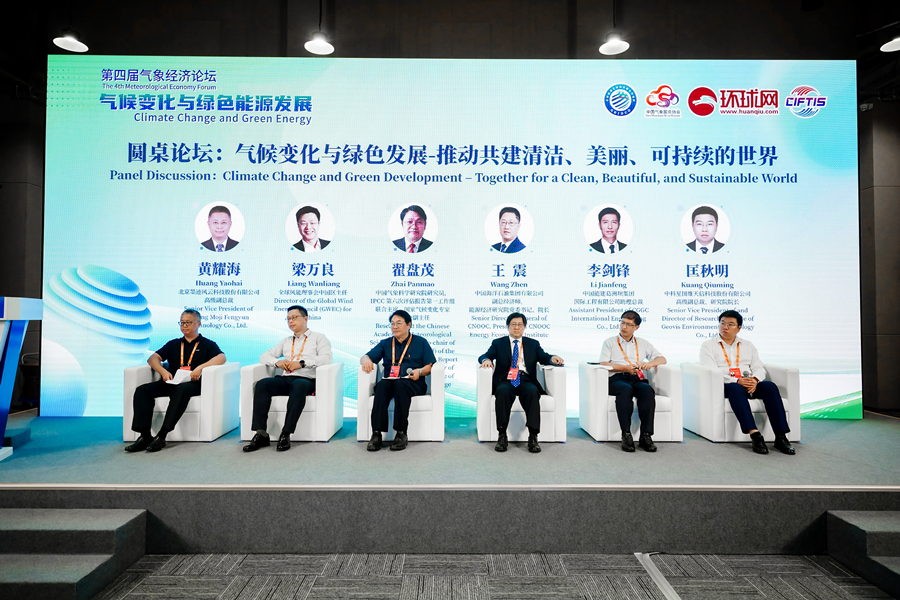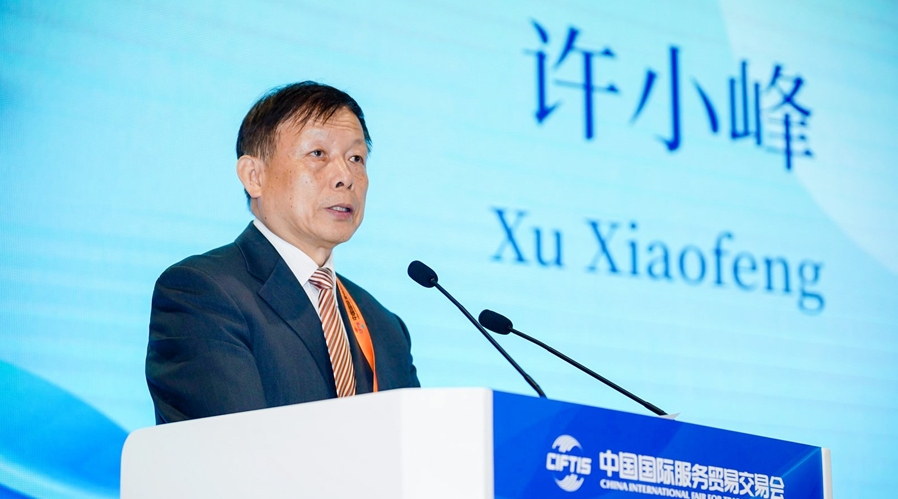The 4th Meteorological Economy Forum, themed "Climate Change and Green Energy," was held on Sept. 11 during the 2025 China International Fair for Trade in Services (CIFTIS) in Beijing. The event brought together international and domestic experts, organizations and business delegates to discuss climate response strategies, energy green transition and the Beautiful China initiative.

Xu Xiaofeng, president of the China Meteorological Service Association, speaks at the 4th Meteorological Economy Forum during CIFTIS 2025 in Beijing, Sept. 11, 2025. [Photo courtesy of CMSA]
Xu Xiaofeng, president of the China Meteorological Service Association (CMSA), stated at the forum that China, as a country that is actively implementing the Paris Agreement, is fully advancing its carbon peaking and carbon neutrality goals.
"By the end of 2024, China's cumulative installed capacity of renewable energy reached 1.41 billion kilowatts, accounting for 42% of the country's total installed capacity," he said. "Among this, wind and solar power installation capacities have ranked first in the world for 15 and 10 consecutive years, respectively, while renewable energy has now surpassed coal power to become the largest source of electricity in the system, demonstrating China's rapid progress, firm commitment and significant achievements in developing green energy and addressing climate change."
On the 10th anniversary of the Paris Agreement in July, leaders from China and the European Union issued a joint statement on climate change, emphasizing that it is crucial for all countries — particularly major economies — to maintain policy continuity and stability while intensifying their efforts to address climate change. However, this January, President Donald Trump signed an executive order once again announcing the United States' withdrawal from the Paris Agreement.
"This has introduced uncertainties into achieving the goals of the Paris Agreement," Xu said. "Addressing this complex situation requires three key actions: first, closely monitoring the subsequent evolution of U.S. policies; second, relying on the joint efforts of the international community; and third, depending on the effectiveness of integrating technological advances with industries."
Liu Zehong, executive vice chairman of the Global Energy Interconnection Development and Cooperation Organization (GEIDCO), noted that wind and solar power currently account for 31% of global installed capacity.
"As the share of new energy continues to rise, its weather-dependent nature has made meteorological conditions an increasingly critical factor affecting the operation of the power system," he said. "Beyond impacting renewable energy, extreme weather and climate events are becoming more frequent, intense and widespread, posing greater threats to energy infrastructure such as the power grid and leading to more pronounced peaks of electricity load."
Liu added that research shows during summer peak periods, every 1 °C increase in the maximum temperature raises the peak load by approximately 4.5%. "This summer, China's maximum electricity load reached 1.51 billion kilowatts, with higher-than-average temperatures being one of the main contributing factors. There is urgent need for the energy and power system to enhance climate resilience, improve adaptive capacity and strive to achieve a higher level of secure energy supply."
2024 was the hottest year on record, with multiple climate indicators signaling extreme conditions. The global average temperature was approximately 1.55 °C higher than pre-industrial levels (1850-1900), surpassing the 1.5 °C warming limit set by the 2015 Paris Agreement for the first time. Atmospheric carbon dioxide concentrations reached their highest level in 800,000 years, while glacier melt, ocean heat content and acidification all hit record highs, and the rate of sea-level rise continued to accelerate.
"Reducing greenhouse gas emissions is more urgent than ever, and climate action is no longer optional," said Zhang Wenjian, adviser to the president of the World Meteorological Organization. "The energy sector accounts for approximately three-quarters of global greenhouse gas emissions, making it imperative to prioritize new energy in climate action plans. The current status of renewable energy and existing commitments fall far short of achieving the goal of ensuring access to affordable, reliable and sustainable modern energy for all by 2030. It is crucial to urgently increase global investment and financing for new energy."

Experts take part in a panel discussion at the 4th Meteorological Economy Forum during CIFTIS 2025 in Beijing, Sept. 11, 2025. [Photo courtesy of CMSA]
The forum also featured a dedicated panel discussion with representatives from leading institutions, with participants exploring pathways for synergizing climate action and green energy development to help build a clean, beautiful and sustainable world.
During CIFTIS, the Global Meteorological Services and Equipment Exhibition was featured in the thematic exhibition area. Various organizations and enterprises showcased advanced achievements integrating meteorological data applications, intelligent observation equipment and precision forecasting technologies into socioeconomic development. The exhibition allowed visitors to gain a firsthand understanding of how meteorological technology provides solid support for low-carbon transformation in sectors such as agriculture, energy and transportation.


 Share:
Share: 




 京公网安备 11010802027341号
京公网安备 11010802027341号